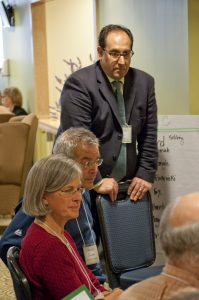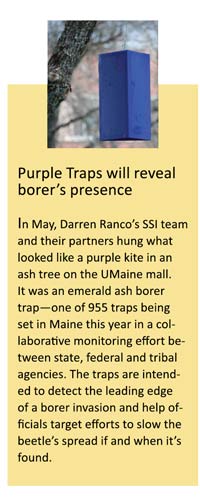Saving Maine’s Basket Trees
 For centuries, Wabanaki artisans have woven exquisite baskets from brown ash, which they call wipiti, or “basket trees.” Now, however, this ancient art form and the basketmakers’ livelihoods are at risk. An invasive beetle called the emerald ash borer has already killed tens of millions of ash trees in the Midwest and Canada, and it’s heading toward Maine.
For centuries, Wabanaki artisans have woven exquisite baskets from brown ash, which they call wipiti, or “basket trees.” Now, however, this ancient art form and the basketmakers’ livelihoods are at risk. An invasive beetle called the emerald ash borer has already killed tens of millions of ash trees in the Midwest and Canada, and it’s heading toward Maine.
The emerald ash borer (EAB) has spread to 15 states and two Canadian provinces since it was first detected in Michigan in 2002. Believed to have arrived on shipping pallets from China, it is now spread mainly by people transporting firewood and has been reported as far east as New York State and Quebec. In 2011, U.S. Forest Service entomologist Nathan Siegert told The New York Times, “Right now, the emerald ash borer is the most destructive insect we have in North America.”
Wabanaki basketmakers in Maine have watched and worried for years. “We were really afraid when the weavers from the Great Lakes started telling us about the emerald ash borer and what it’s doing to the ash trees in Michigan,” says Jennifer Neptune, a member of the Maine Indian Basketmakers Alliance. “If and when it comes here, it will be devastating if it kills all our trees. That will be another tradition that will just be lost.”
Maine’s basket trees, however, stand a decent chance. SSI researchers are teaming up with Wabanaki basketmakers like Neptune, along with tribes and state and federal agencies, to fight the destructive beetle. Launched in 2009 by Darren Ranco, associate professor of anthropology and Chair of Native American Programs at UMaine, this is the first project in the U.S. to work with tribes from the beginning to develop proactive policies and strategies to fight an EAB invasion.
Ranco’s team is helping state and tribal agencies develop emergency response plans, which outline steps for addressing a borer invasion, from monitoring and control to communication and quarantines. The researchers have developed guidelines based on an analysis of EAB emergency response plans in nine other states by SSI graduate student Erin Quigley. They are now sharing lessons learned with their partners, and helping them put best practices into action.
The SSI team’s analysis revealed an important oversight: none of the emergency response plans in other states addressed how an EAB invasion would affect tribes, or how to involve tribes in a response. Yet policies aimed at fighting the borer also would have an impact on tribes, particularly basketmakers and harvesters, says Ranco.
“Emergency response planning sometimes has a very top-down approach,” Ranco says. “We want to make sure that the planning in Maine allows for input from the bottom-up and that the basketmakers’ needs and interests are served and communicated along the chain of command.”
To that end, the team has made recommendations such as coordinating communication between state, tribal and federal agencies on EAB policies and working out potentially sticky issues ahead of time, such as whether or not tribal lands would be included in county-wide quarantines of infested areas. The SSI researchers and their partners have formed working groups on communication and jurisdictional issues to act on these recommendations.
Nailing down such details ahead of time benefits everyone, Ranco observes. He gives the example of making sure tribes know whom to contact if they spot the borer. “Those gathering ash for basketmaking might be some of the first to detect an invasion,” he says, “while those who are making hardwood pulp might not even notice it.”
Western Science Meets Indigenous Knowledge
While Ranco and others make progress on policy, team member Bill Livingston and graduate student Kara Lorion are collaborating with tribes on another challenge: safeguarding the state’s best stands of brown ash, which is uncommon in Maine. They are working with Wabanaki ash harvesters, who process the trees by hand into basket splints.
Livingston, UMaine associate professor of forest resources, joined the harvesters in the forest last summer to learn what makes the best quality basket trees. He is now combining that information with ecological data and GIS technology to map out areas of the state most likely to have the best basket trees.
“The idea is to identify and protect the high quality basket trees,” Livingston says, “so that if the EAB does get here, we’ll be able to look for areas likely to have brown ash and focus on preventing the beetle from reaching them.”
Creating a Statewide Safety Net
Ranco’s team also is working on education and outreach. In 2009, Ranco brought a group of basketmakers to Michigan to learn how to identify an EAB infestation. In 2010, team member John Daigle, UMaine associate professor of forest recreation management, joined other experts in presenting testimony to the Maine State Legislature, which led to a ban on imported firewood to help prevent the borer’s spread. The team also is working with Indian Island youth and the Maliseet tribe in Houlton on collecting and saving brown ash seeds. Each piece of the project fortifies a growing network that can make all the difference should the borer reach Maine, according to those on the front lines. “SSI brings everyone together,” says Dave Struble, an entomologist with the Maine Forest Service, which is a project partner. “The community net is built, and that means the response to an emerald ash borer invasion can be much faster because we’re working together. If we can find the insect early, we can start to contain it and slow its buildup and spread.”
Slowing the EAB down could give scientists and nature more time to keep it in check. While methods such as injecting insecticides and using quarantines help, so do natural predators like woodpeckers and parasitic wasps, as well as fungi. Buying time also would allow scientists to develop additional natural control methods.
In other words, there’s hope. “We’ve got this program and we’ve got some tools. I see this as a model,” Struble says. “The collaborative approach is the only way that’s going to be effective, along with keeping the public engaged and involved.”
Collaboration has been Ranco’s priority from the beginning. The project began when he and Daigle, both members of the Penobscot Nation, met with tribes to learn about their biggest concern, which turned out to be the borer. They have been engaging new partners to help ever since.
“The different perspectives that people bring to our meetings are very exciting,” Ranco says. “State foresters, university researchers, and basketmakers and tribal ash harvesters are each talking from their perspective, but we’re all trying to solve the problem together.”
What’s at stake is much more than trees. The brown ash is at the center of Wabanaki culture. A Wabanaki creation story says humans were created when when the trickster hero Gluskabe shot an arrow into a brown ash tree.
See More…
